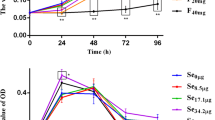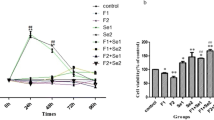Abstract
This study aimed to investigate the role and molecular mechanism of L-type calcium channel (LTCC) on fluoride exposure-induced kidney injury. Subchronic and chronic fluoride exposures were included in the experiment. Each part contained 140 ICR male mice. They were randomly divided into 7 groups: control group, high-fluoride group (NaF 30 mg/L), low-fluoride group (NaF 5 mg/L), high/low-fluoride + agonist (FPL64176) group, high/low-fluoride + inhibitor (nifedipine) group. One week before the end of fluoride exposure, each mouse in the fluoride exposure group was injected intraperitoneally with LTCC agonist (FPL64176) or inhibitor (nifedipine) (5 mg/kg day). The apoptosis of kidney cell was observed by TUNEL, and the protein expression levels of Cav1.2 and CaM, CaMKII, Bcl-2, and Bax were detected by Western blot. Compared with the control group, the protein expression levels of Cav1.2, CaM, and Bax significantly increased, and those of CaMKII and Bcl-2 significantly decreased, the ratio of Bax/Bcl-2 also significantly increased, and the number of apoptotic kidney cells significantly increased in the high/low-fluoride group and in the high/low-fluoride + agonist group. The above indicators and fluoride exposure concentrations showed in time- and dose-dependent changes. Compared with the high/low-fluoride + agonist group, the protein expression level of the molecular in the kidney cells above mentioned was significantly opposite and the number of apoptotic kidney cells significantly decreased in the high/low-fluoride + inhibitor group. In conclusion, LTCC mediates the kidney injury induced by fluoride exposure in mice. Fluoride exposure induced abnormal expression of the Cav1.2 protein, Ca2+ signal transduction pathway, and apoptosis-regulated proteins, which is one of the molecular mechanisms. Nifedipine may be a new and effective anti-fluoride drug.









Similar content being viewed by others
References
Luo K, Liu Y, Li H (2012) Fluoride content and distribution pattern in groundwater of eastern Yunnan and western Guizhou, China. Environ Geochem Health 34(1):89–101
Sivasankar V, Rajkumar S, Murugesh S, Darchen A (2012) Tamarind (Tamarindus indica) fruit shell carbon: a calcium-rich promising adsorbent for fluoride removal from groundwater. J Hazard Mater 225:164–172
Xue C, Chen X, Yang K (2000) Antagonistic effects of selenium and zinc on fluoride-induced kidney injury. Health Research 29(1):21–23
Zhang R, Liao QX, Ke L, Ouyang W, Zhang ZG (2017) The molecular mechanisms of the renal injury in fluorosis induced by drinking water with a high fluoride ion content and the effects of selenium intervention. Fluoride 50:105–120
Zhang R, Liao QX, Ke L, Ouyang W, Zhang ZG (2017) Effect of calcium on kidney mitochondrial damage in offspring rats were exposed to fluoride after sub. Environmental and occupational medicine 34(2):154–159
Sun Y, Ke L, Zheng X, Li T, Ouyang W, Zhang ZG (2017) Effects of different levels of calcium intake on brain cell apoptosis in fluorosis rat offspring and its molecular mechanism. Biol Trace Elem Res 176(2):355–366
Zhang W, Sun L, Xue L (2006) Correlation between intracellular calcium overload in rats with nutritional low calcium and chronic fluorosis. Chinese Journal of Endemiology 25(6):622–624
Wang SQ, Song LS, Lakatta EG (2001) Ca2+ signalling between single L-type Ca2+ channels and ryanodine receptors in heart cells. Nature 410(6828):592–596
Guo HY, Wang ZS, Wu Y, Sun Y (2015) Quality control practice of pathological HE staining. Guide of China Medicine 24(13):41–42
Kasahara I, Saitoh K, Nakamura K (2000) Apoptosis in acute hepatic failure: histopathological study of human liver tissue using the TUNEL method and immunohistochemistry. Journal of medical and dental sciences 47(3):167–175
Liu L, Hang Y, Gu H, Zhang K, Ma L (2015) Fluorosis induces endoplasmic reticulum stress and apoptosis in osteoblasts in vivo. Biol Trace Elem Res 164(1):64–71
Lou DD, Guan ZZ, Liu YJ (2013) The influence of chronic fluorosis on mitochondrial dynamics morphology and distribution in cortical neurons of the rat brain. Arch Toxicol 87(3):449–457
Xiong CL, Li WD, Fan ZX (2017) Relationship between fluoride content in drinking water and dose response in children with dental fluorosis. Chinese Journal of Endemiology 36(02):100–103
Huang JH, Huang XH, Chen ZY (2004) Equivalent dose conversion between animals and animals and human body in pharmacological tests. Chinese Journal of Clinical Pharmacology and Therapeutics 9(9):1069–1072
Ma XJ (2008) Toxic effects of fluoride on the kidney. Chinese Journal of Endemic Diseases 27(4):470–471
Gao Q, Wang SL, Yu YN (2005) Free radical content and morphological changes in the kidney of rats with chronic fluorosis. Guizhou Medicine 29:213–215
Meng GY, Wang DX, Wang Y (2014) Study on the mechanism of liver damage induced by chronic fluorosis in rats. Med Inf 27(2):45–46
Zhang L, Yang YZ, Zhang Z (2012) Intervention of selenium on liver damage induced by fluorosis in rats. Health Research 41(4):141–145
Yang K, Zhang J, Jiang HL, Zhu WL, Wang XC (2009) The conformational change path of calmodulin. Journal of Dalian University of Technology 49(4):499–505
He GL (2013) Molecular mechanism of Ca2+-dependent binding of Cam to Cav1.2 channel. China Medical University
Mukhopadhyay D, Srivastava R, Chattopadhyay A (2015) Sodium fluoride generates ROS and alters transcription of genes for xenobiotic metabolizing enzymes in adult zebrafish (Danio rerio) liver: expression pattern of Nrf2/Keap1 (INrf2). Toxicol Mech Methods 25(5):1–10
Wu Y (1997) Apoptosis and glomerular disease. Nanjing General Hospital of Nanjing Military Region 3:253–257
Li XH (1998) Gene regulation of apoptosis and its biological significance. Journal of Changyi Teachers College 2:24–26
Nazıroğlu M (2011) TRPM2 channel membrane currents in primary rat megakaryocytes were activated by the agonist ADP-ribose but not oxidative stress. J Membr Biol 241(2):51–57
Naziroglu M, Uguz AC, Ismailoglu Ö, Özgül C, Borcak M (2013) Role of TRPM2 cation channels in dorsal root ganglion of rats after experimental spinal cord injury. M. Seismic exploration of the deep continental crust :. Birkhauser Verlag
Fujita T (2000) Calcium paradox: consequences of calcium deficiency manifested by a wide variety of diseases. J Bone Miner Metab 18(4):234–236
Chen YP (2009) Kidney protection of different types of dihydropyridine calcium channel blockers. Beijing Medical Journal 31(3):178–180
Lashgari R, Motamedi F, Noorbakhsh SM, Zahedi-Asl S, Haghparast A (2007) Assessing the long-term role of l-type voltage dependent calcium channel blocker verapamil on short-term presynaptic plasticity at dentate gyrus of hippocampus. Neurosci Lett 415(2):174–178
Hua K (2002) Effects of excessive fluoride on osteoclasts and its mechanism. Jilin University, Jilin
Yu QL, Shao DD, Zhang R, Ouyang W, Zhang ZG (2019) Effects of drinking water fluorosis on L-type calcium channel of hippocampal neurons in mice. Chemosphere 220:169–175
Liao Q, Zhang R, Wang X, Nian W, Ke L, Ouyang W, Zhang ZG (2017) Effect of fluoride exposure on mRNA expression of Cav1.2 and calcium signal pathway apoptosis regulators in pc12 cells. Environ Toxicol Pharmacol 54:74–79
Toscano CD, O’Callaghan JP, Tomás R, Guilarte (2005) Calcium/calmodulin-dependent protein kinase ii activity and expression are altered in the hippocampus of pb2+-exposed rats. Brain Res 1044(1):51–58
Zhang J, Zhu WJ, Xu XH, Zhang ZG (2011) Effect of fluoride on calcium ion concentration and expression of nuclear transcription factor kappa-b ρ65 in rat hippocampus. Exp Toxicol Pathol 63(5):407–411
Zhang J, Zhang ZG (2013) Effects of chronic fluorosis on CAMKIIα, c-FOS, BAX, and BCL-2 channel signaling in the hippocampus of rats. Fluoride 46(3):135–141
Dai LW (2017) Fluoride content in drinking water and human health. China Urban and Rural Enterprise Health 11:34–37
Funding
This research was sponsored by the National Natural Science Foundation of China (grant number: 81573101).
Author information
Authors and Affiliations
Corresponding authors
Additional information
Publisher’s Note
Springer Nature remains neutral with regard tished maps and institutional affiliations.
Rights and permissions
About this article
Cite this article
Shao, D., Zhang, J., Tang, L. et al. Effects and Molecular Mechanism of L-Type Calcium Channel on Fluoride-Induced Kidney Injury. Biol Trace Elem Res 197, 213–223 (2020). https://doi.org/10.1007/s12011-019-01987-x
Received:
Accepted:
Published:
Issue Date:
DOI: https://doi.org/10.1007/s12011-019-01987-x




